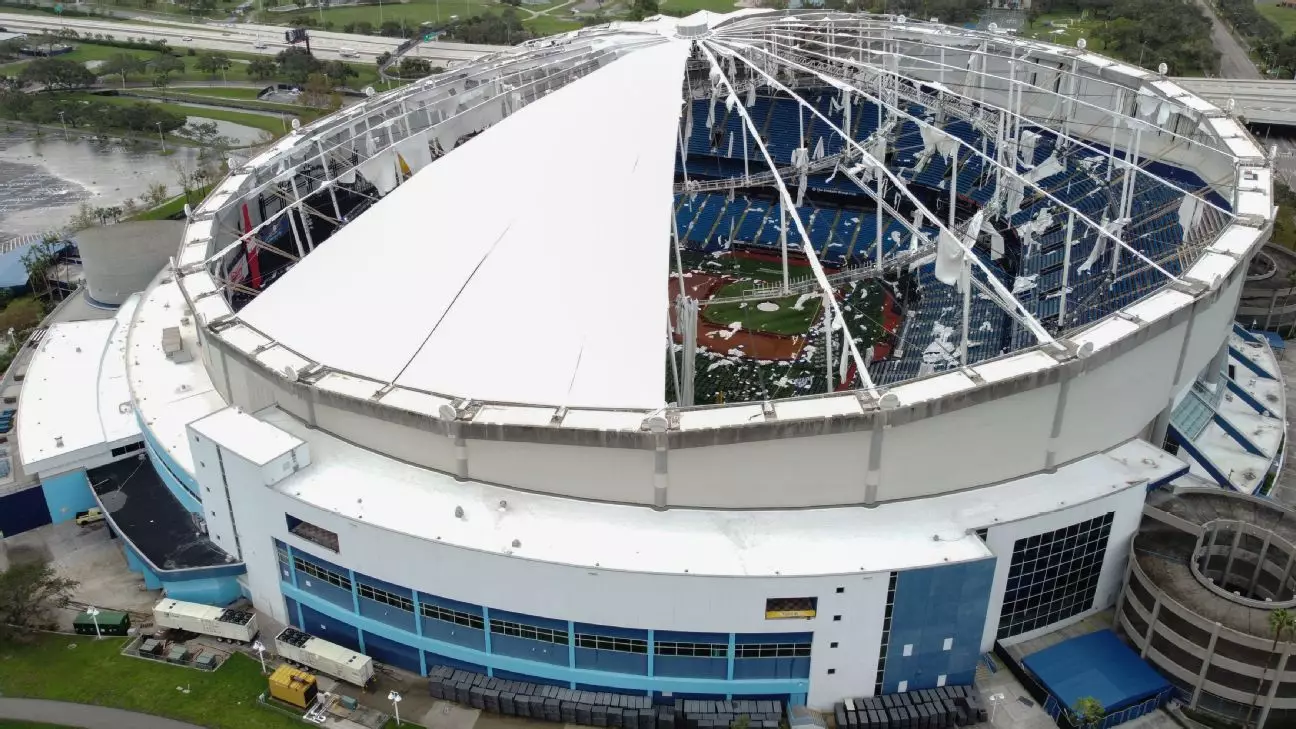In a decisive move, the St. Petersburg City Council has voted to allocate $22.5 million for repairs to Tropicana Field, the home of the Tampa Bay Rays, following the catastrophic damage inflicted by Hurricane Milton. The decision, which received a 7-1 vote, marks not only a moral commitment to maintaining the stadium but also a strategic effort to restore a key component of the region’s sports culture by aiming for readiness by the 2026 baseball season. This repair endeavor begins with a new membrane roof, crucial for facilitating further enhancements to the ballpark, and emphasizes the “we have to do this” mentality that permeates city governance.
The hurricane’s devastating impact has forced the Rays to temporarily relocate their home games to Steinbrenner Field in Tampa, a move that has incurred logistical challenges and an uncertain atmosphere for players and fans alike. The Rays’ initial success at this interim venue—boasting a 4-2 record—affords them a glimmer of hope, but the uncertainty about their long-term future remains palpable.
Understanding the Legal Framework Behind the Repairs
Council member Lissett Hanewicz, who practiced law before her political career, reiterated the legal obligations tied to the stadium, stating, “We need to go forward with the roof repair so we can do the other repairs.” This highlights an insight into the intricate balance between legal binding and fiscal efficacy. Despite the Rays having bowed out of negotiations for a lavish new $1.3 billion stadium, the contractual stipulations necessitate the repair work under existing agreements, raising pressing questions about fiscal responsibility versus community investment.
Political will appears to be the driving force behind the commitment to repair the Trop. However, as council member Brandi Gabbard expressed, the expenditure does evoke a sense of annoyance: “I don’t like it more than anybody else. I’d much rather be spending that money on hurricane recovery.” This illustrates the nuanced perspectives within city governance—on one hand, fulfilling obligations to a professional sports franchise, and on the other hand, addressing the broader community needs post-hurricane.
Complex Repairs Ahead: What’s in Store for Tropicana Field?
The trajectory of repairs extends far beyond just a roof replacement. City architect Raul Quintana detailed an estimated total repair operation costing around $56 million. The project encompasses not only the installation of a wind-resistant roof capable of withstanding gusts of 165 mph but also vital upgrades to the playing surface, audio-visual systems, and essential facilities, including concession stands.
As the city attempts to steer through this multifaceted renovation endeavor, one thing is abundantly clear: the stakes are incredibly high. The overlap of sports culture and economic vitality in the Tampa Bay region underscores how vital a successful renovation would be—not just for the team, but for the community that rallies around it.
Shifting Landscape: What Lies Ahead for the Rays
With uncertainty looming over the Rays’ intentions moving forward, the next few years hold significant implications for the franchise and its fan base. Despite pledging to play at the Trop through 2028, the Rays’ previous withdrawal from the new stadium deal raises eyebrows regarding their long-term commitment to St. Petersburg. Local discussions about potentially relocating to Tampa or another site only add to the uncertainty surrounding their future.
Major League Baseball has echoed sentiments reinforcing the importance of keeping the Rays in the Tampa Bay area, yet without a solid agreement in place, the franchise’s future is muddied at best. The complexities of the evolving relationship between the Rays, the city, and its residents necessitate strategic collaboration and forward-thinking policy to ensure the retention of professional sports in the community.
This scenario illustrates not merely a realization of contractual agreements and repair commitments but rather a broader narrative about identity, community pride, and a deep cultural connection that professional sports foster. As St. Petersburg takes steps to breathe new life into Tropicana Field, it must simultaneously keep a pulse on the heartfelt sentiments of its citizens while navigating a complex web of legal, financial, and operational considerations. The outcome of these repairs might very well define baseball in the region for years to come.


Leave a Reply